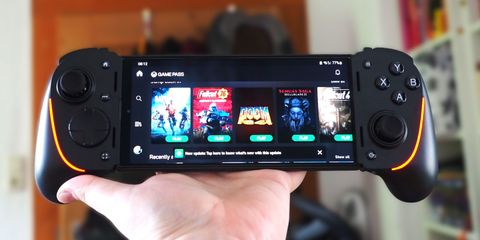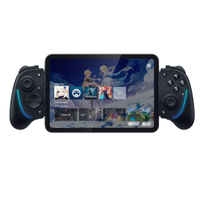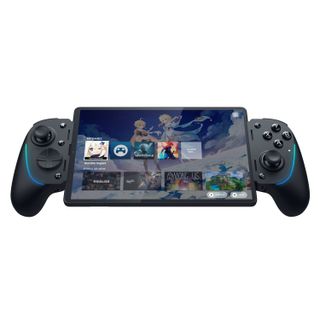Windows Central Verdict
The Razer Kishi Ultra is "Ultra" in every regard. Best-in-class ergonomics, premium materials and design, and enduring quality. It's also "Ultra" in terms of price. There are much cheaper options that will "get the job done" as far as mobile and cloud gaming is concerned, but if you want the best of the best, look no further.
Pros
- +
Best-in-class ergonomics, sticks, and triggers for mobile gaming.
- +
Supports a wide range of devices, even with slim cases
- +
Pass-through USB-C charging and 3.5mm audio
- +
Razer's Nexus software is solid (and free)
- +
Impressive universal audio-based haptics (for Android and PC)
- +
RGB Chroma makes everyone a better gamer (but yes, you can turn it off).
Cons
- -
The USB-C connector is rigid, which makes it a bit fiddly to remove devices.
- -
Large design boosts comfort but reduces portability for travel and storage.
- -
Very expensive.
Why you can trust Windows Central
Say hello to Razer's premium mobile controller option after years of iteration. This is the Razer Kishi Ultra, currently $149.99 at Amazon.
So far, I've tested every version of Razer's mobile controller efforts. This goes all the way from the dual-sided Razer Junglecat a few years ago to the Razer Kishi V1 and V2 iterations. You could arguably call the Razer Kishi Ultra the "V3" given how different it is from its predecessors. Different, and better in almost every regard.
Razer competes with various other manufacturers in an increasingly busy space. Mobile gaming is utterly huge, with players of games like Genshin Impact and Call of Duty Mobile increasingly ditching the fiddly touch controls for something more tactile and ergonomic. Of course, you can use any and every best Xbox controller with Bluetooth capabilities on Android and iOS devices as of writing, but what if you wanted something that could incorporate your mobile device itself?
There's a truly vast array of options out there. The best mobile controllers for Xbox Cloud Gaming and mobile gaming in general include brands like Backbone, GameSir, and, of course, Razer itself. Increasingly, though, I think Razer is emerging as a champion of sorts, at least when you disregard price.
The Razer Kishi Ultra is an exemplary piece of tech and essentially takes everything Razer has learned from previous iterations and its excellent Razer Wolverine controller line and bakes it into this ultimate mobile gaming experience. Is it worth that $149.99 price tag, though? That's the real question here.
Disclaimer
This review was made possible with a review sample provided by Razer. The company did not see the contents of the review before publishing.
Razer Kishi Ultra: Pricing and specs
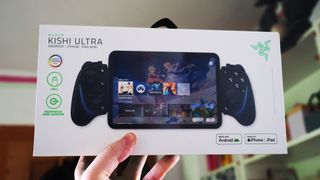
• Price: $149.99 at Amazon.
• Inputs: 6x shoulder buttons (with two programmable), ABXY front-facing buttons, 8-directional d-pad, Hall Effect triggers.
• Ports: USB-C female charging pass-through, 3.5mm audio, USB-C male integrated.
• Features: Nexus software with touch control button mapping, live streaming capabilities. Audio-triggered haptic vibrations (Android and PC only).
• Compatibility: PC, Mac, and iPad via USB-C cable. Android and iOS devices up to 8-inches with integrated USB-C.
• Weight: 607g (1.34 lbs).
The Razer Kishi Ultra is a true beast of a device, with a huge variety of features and an incredibly high-quality package. This is essentially the Razer Wolverine V2 Chroma split in two and extended between a clever clamp to wrap around your mobile device, regardless of shape and size, up to 8 inches.
This incorporates the new iOS devices with USB-C, up to the iPad Mini, and also works on PC with a USB-C cable. It works nearly universally on Android, again owing to USB-C, and rubber inserts inside the box help you tailor the fit to any device.
It sports USB-C pass-through charging underneath if your phone starts to run out of juice and has a 3.5mm audio socket for headsets if you're still living in a Bluetooth-free world. The Nexus software also allows you to assign regions of the touch display to different buttons (at least on Android), allowing you to control touch-based games with a more tactile feel. Hall Effect triggers and satisfyingly clicky buttons accompany the overall package, complete with extra programmable shoulder buttons and a screenshot key for taking quick snaps. It even sports RGB Chroma lighting strips.
The big question is the price tag, though. It's $149.99, making it the most expensive mobile gaming controller of its type. Is the Razer Kishi Ultra worth it? Read on to find out more.
Razer Kishi Ultra — $149.99 at Amazon
The Razer Kishi Ultra is one of the only devices of its kind that can support 8-inch tablets like the new USB-C iPad Mini without delivering compromises in quality. The compromise is, however, a hefty price tag. But if you want the best of the best, the Razer Kishi Ultra may well and truly be it.
See at: Amazon
Razer Kishi Ultra: Design and features
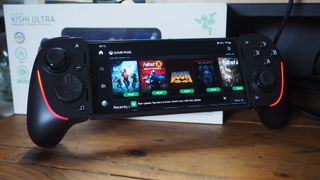
As mentioned, the Razer Kishi Ultra is essentially what would happen if you took a Razer Wolverine V2 Chroma and split it into two parts, connected with a telescopic clamp. The clamp is broad enough to fit devices up to 8 inches, which makes it the only mobile controller in this quality range that supports things like the new iPad Mini, which now sports USB-C, ditching Apple's fading lightning port.
One of the early criticisms I had of mobile controllers that attempted to incorporate additional devices, like phones and tablets, was their size. Early attempts tried to match the controllers up to the mobile devices in question, which became seriously uncomfortable over time, particularly if you have larger hands (or even average adult hands, frankly). There's a reason PlayStation and Xbox controllers are the way they are: they've undergone years upon years of ergonomic iteration to get to this point, but third-party controller manufacturers only recently seem to have gotten the memo.
The Razer Junglecat, Kishi V1, and even V2 Kishi fell afoul of this "controller for ants" problem, trying to balance being smaller for portability with being comfortable and ergonomic. The Razer Kishi Ultra goes all in on being ergonomic, frankly, and I quite merrily played Xbox Game Pass cloud gaming (Jedi Survivor) for a couple of hours this morning quite comfortably.
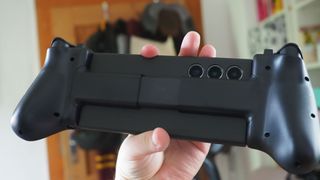
Indeed, this is essentially a Razer Wolverine V2 Chroma, which is arguably the best non-Microsoft Xbox controller money can buy right now. In terms of pure comfort, the Razer Kishi Ultra is a pure win here, with textured palm grips, angled and grippy triggers, and satisfyingly clicky buttons. I am once again enamoured with Razer's capabilities in this space, after decades of handling sub-par third-party Xbox controllers, but we'll go deeper on how it feels to use in the next section.
In terms of raw features, the Razer Kishi Ultra utterly nails it. The Razer Kishi Ultra is easily the most feature-rich mobile gaming controller on the market right now. Razer nailed the basics, with USB-C pass-through for charging your phone while still having the controller connected, 3.5mm audio sockets to rock your wired best gaming headsets, and additional buttons to sweeten the deal.
In terms of raw features, the Razer Kishi Ultra utterly nails it. The Razer Kishi Ultra is easily the most feature-rich mobile gaming controller on the market right now.
But here's where the Razer Kishi Ultra tends to over-deliver: configurable RGB Chroma lightning, audio-based universal haptics that add dynamic vibrations to any game, and software-based touch button mapping to add full gamepad controls to games that don't support gamepads. For some reason, Genshin Impact on Android doesn't support controllers, even though it does so on PC. It doesn't matter, though, thanks to the Razer Nexus app, since you can designate the on-screen touch buttons to map to the joysticks, triggers, and buttons on the controller anyway. It's a great touch, coupled with the ability to record the screen into the app and also stream on services like Twitch and YouTube. Razer doesn't charge extra for the capability either, unlike some of its competitors.
The feature set on the Razer Kishi Ultra is rock solid, if you actually plan to use all of it, that is. $149.99 is a lot to ask for a device like this, particularly since there are much cheaper options on the market. Does the price factor into usability at all? Read on.
Razer Kishi Ultra: Hardware and performance







One signifier for me of a good product is if I forget that I'm supposed to be doing a review and just start simply enjoying it. That's exactly what happened this morning with the Razer Kishi Ultra.
I fired up Xbox Game Pass and Xbox Cloud Gaming to test this thing out first, with my trusty old and similarly ultra Samsung Galaxy S24 Ultra in tow. The first thing to note is that I love how the Razer Kishi Ultra can fit my phone without me having to take the case off. It's rare that I've used these types of mobile controllers that actually remember that the vast majority of people actually use a case on their phone and don't feel like removing it every single time they want to use the device.
Manufacturers have gotten better with this over the years, and the Kishi Ultra is part of that story. In the box is a variety of rubber inserts to make your device a more suitable fit here. I should note, though, that really bulky cases or even moderately bulky cases probably still won't fit. I have a very specific thin leather case on my Samsung Galaxy S24 Ultra, and it was quite a snug fit.
Speaking of fits, the only real downside of this overall design, in my view, is the connector. As I understand it, a USB-C pivot is actually patented by another company, meaning that Razer's solution to just have a protruding USB-C connector is, moreover, due to necessity rather than preference. The downside there, though, is that it feels a bit spooky when you're trying to remove the device, given that it's very rigid and you need to pull it up to get it out. I can see less careful individuals potentially damaging the Razer Kishi Ultra or even their phones if they try to angle it out too harshly. It's not a big deal, but it is something to be aware of.
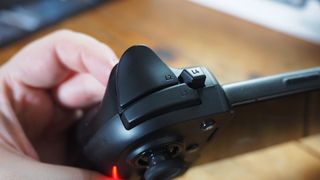
From here, though, there are no real downsides. This is an incredibly pleasant device to use. As I noted in the intro to this section, I completely forgot I was supposed to be reviewing this thing and ended up just spending 90 minutes playing through Jedi Survivor on Xbox Game Pass via cloud gaming. The sticks are rock solid with configurable dead zones and have virtually no discernible difference from Microsoft's own Xbox sticks.
The face buttons, shoulder buttons, and d-pad, though, are actually even better than Microsoft's, with a satisfyingly clicky actuation. Sadly, the triggers don't have that clicky feel, but they still get the job done. They have a winged shape, which makes them easy to grip and activate, and they sport a Hall effect design, which means they should be less susceptible to wear and tear, relying less on mechanical parts to activate. It's a shame we didn't get Hall effect sticks to complement, but we can't have everything in life, can we?
What we can have is next-level comfort. I rocked a variety of games with this thing over the course of testing, and it felt as comfortable as using any first-party gaming controller from the likes of Xbox or PlayStation. While the larger design does make it less portable for travel purposes (and yes, there's no way you'd be able to fit this in your pocket), it results in a big boost in comfort. You'll be able to use the Razer Kishi Ultra for hours without feeling any fatigue. I can't say the same for some other similar devices out there since they get a bit cramped and compact while trying to be more travel-friendly.
The larger size also gives the overall experience a more balanced feel, accommodating larger devices more ergonomically than a smaller controller might. But you'll have to decide for yourself if you want something larger and more comfortable, at the cost of something more compact and portable. It's by no means heavy, but it's certainly not discrete.
Razer Kishi Ultra: Competition
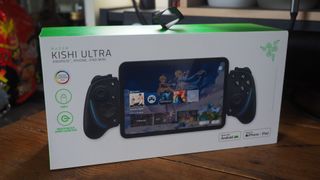
There are a metric ton of competing devices in this space of all shapes and sizes for all user scenarios. Of the most notable, we have the Turtle Beach Atom, the Backbone One, Razer's own Kishi V2, and devices like the GameSir X2 and GameSir G8 Galileo.
The notable thing about all of Razer's Kishi Ultra competitors is that they are all significantly cheaper, besides the Backbone One. It's also undeniable in my view that the Razer Kishi Ultra simply offers a best-in-class experience, though, with superior joysticks, triggers, and buttons compared to the vast majority of competing solutions out there. But you need to ask yourself if you really want to spend so much on a device like this. The Razer Kishi V2 will save you $50, for example, and while it's a bit more cramped and compact, it still offers a rock-solid experience. The Turtle Beach Atom is just $80 and has a unique collapsible, pocketable design, making it ideal for travel. And while its inputs aren't quite as good as Razer's, they're more than capable. The GameSir G8 Galileo is also around $80, and while, again, its inputs aren't quite as good as Razer's, it gets the job done and has a similarly large, comforting design.
The Razer Nexus app adds a whole host of great features that sweeten the deal on top of Razer Chroma if you're an RGB enjoyer. The haptics are also a really nice touch and give you a glimpse at a true console native experience on your mobile device. I honestly can't see myself using any controller for Xbox Cloud Gaming that isn't the Razer Kishi Ultra after getting my hands on one — but I also got this as a review unit. Would I drop $149.99 on a device like this?
It's hard to say. I think you'd need to really love cloud and mobile gaming to justify it. It's hard to deny its quality, though. I just wish it was closer to $99 as someone who doesn't play a ton of cloud or native mobile games but enjoys the option occasionally. But if you're someone who wants the best of the best, seriously, look no further. The Razer Kishi Ultra is it.
Razer Kishi Ultra: Should you buy it?

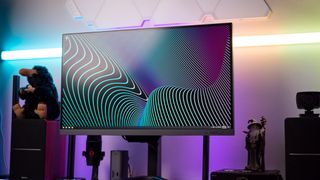
• Best Xbox headsets / PC headsets
• Best Xbox controllers
• Best Xbox accessories
• Best small gaming PCs
• Best gaming laptops
I love this device. It's immaculate, with gorgeous inputs, superior ergonomics, and enduring comfort. If playing games on my phone wasn't a nightmare for my neck (Razer RGB neck brace, next?), I could see myself spending hours upon hours with this controller specifically, much like its Razer Wolverine V2 cousin.
I can't even bring myself to consider using a competing device for mobile gaming now, whether it be native or cloud. I am, however, cognizant of the fact I didn't pay for this review unit. When I consider its $149.99 price tag, I find myself wishing it was closer to $99.
There are a lot of bells and whistles here that are fun and enjoyable but aren't really necessary, such as RGB lighting and so on. This is definitively a best-in-class premium experience — and if that's what you want, then awesome. The Razer Kishi Ultra is absolutely undeniably a best-in-class experience. But there are a similarly undeniable amount of much cheaper options that will also get the job done.
You should buy this if ...
✅ You want a best-in-class mobile controller with all the bells and whistles of a standard console controller, complete with high-end ergonomics and haptic vibrations.
✅ You enjoy flair like Razer Chroma and want to add some tactile controls to an 8-inch tablet like an iPad Mini.
You should not buy this if ...
❌ If you don't fancy the haptics, RGB lighting, or larger more comforting design, there are much cheaper options that will get the job done.
The Razer Kishi Ultra lives up to its namesake, for sure. When you say "Ultra," you really are touting the idea of bringing everything and the kitchen sink to the table, and Razer absolutely delivers. I think after a few sales and price cuts, this will be far, far easier to recommend to everybody. But right now, it's clearly intended to be the world's premium option. There's nothing wrong with that, though, if that's what you want.
The Razer Kishi Ultra is well and truly the best at what it does; just be prepared to pay for it.

Jez Corden is a Managing Editor at Windows Central, focusing primarily on all things Xbox and gaming. Jez is known for breaking exclusive news and analysis as relates to the Microsoft ecosystem while being powered by tea. Follow on Twitter (X) and Threads, and listen to his XB2 Podcast, all about, you guessed it, Xbox!
